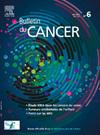Métastases leptoméningées dans le cancer du sein – État des lieux et perspectives
IF 0.8
4区 医学
Q4 ONCOLOGY
引用次数: 0
Abstract
Les métastases leptoméningées du cancer du sein se définissent par l’envahissement des leptoméninges et du liquide cérébro-spinal par des cellules tumorales. Autrefois associées à un pronostic très sombre et une survie d’à peine quelques semaines, leur prise en charge a profondément évolué. Les avancées thérapeutiques, comme l’introduction de thérapies ciblées et une meilleure compréhension de la physiopathologie des métastases leptoméningées, favorisent aujourd’hui un diagnostic plus précoce, grâce à des séquences IRM dédiées et une analyse du liquide cérébro-spinal optimisée. La classification EANO-ESMO distingue notamment les métastases leptoméningées de type I (cytologie positive) à plus mauvais pronostic, mais plus sensibles aux traitements intrathécaux, et les métastases leptoméningées de type II (cytologie négative ou incertaine) souvent plus réceptives aux approches locorégionales telles que la radiothérapie. Les données issues de larges cohortes rétrospectives soulignent l’importance des traitements combinés : thérapies systémiques, injections intrathécales, radiothérapie, ainsi que la prise en charge précoce des symptômes et des soins palliatifs. Cette approche multidisciplinaire améliore la survie médiane, atteignant désormais plusieurs mois, voire parfois au-delà de dix mois dans les métastases leptoméningées HER2+. Des essais cliniques novateurs, à l’image de l’essai multicentrique français ETIC-LM (NCT05800275) évaluant l’association de trastuzumab intrathécal, de tucatinib oral et de capécitabine orale, ouvrent de nouvelles perspectives. Bien que le pronostic reste sévère, ces progrès dessinent un avenir plus favorable, avec un meilleur contrôle de la maladie et une amélioration de la qualité de vie des patients atteints de métastases leptoméningées.
Leptomeningeal disease (LMD) from breast cancer is defined by the invasion of the leptomeninges and cerebrospinal fluid (CSF) by tumor cells. Historically associated with a very poor prognosis and survival measured in weeks, their management has evolved considerably. Therapeutic advances, such as the introduction of targeted therapies, and a better understanding of the pathophysiology of LMD now enable earlier diagnosis through dedicated MRI sequences and optimized CSF analysis. The EANO-ESMO classification notably distinguishes type I LMD (cytology-positive), which carries a worse prognosis but is more sensitive to intrathecal (IT) treatments, from type II LMD (negative or uncertain cytology), often more responsive to local-regional approaches like radiotherapy. Data from large retrospective cohorts highlight the importance of combination therapies: systemic treatments, IT injections, radiotherapy, as well as early symptomatic and palliative care. This multidisciplinary approach improves median survival, now reaching several months, and can even surpass 10 months in HER2+ cases. Innovative clinical trials, such as ETIC-LM (NCT05800275) – a French phase II study evaluating the combination of IT trastuzumab, oral tucatinib, and oral capecitabine offer encouraging new strategies for patient care. Although the prognosis remains poor, recent advancements suggest a more hopeful future, providing better disease control and improved quality of life for patients with LMD from breast cancer.
[乳腺癌中的轻脑膜疾病:现状和未来方向]。
乳腺癌引起的轻脑膜病(LMD)的定义是肿瘤细胞侵入轻脑膜和脑脊液(CSF)。从历史上看,这种疾病的预后很差,生存期以周为单位,现在的治疗方法已经有了很大的发展。治疗方面的进步,如靶向治疗的引入,以及对LMD病理生理学的更好理解,现在可以通过专门的MRI序列和优化的CSF分析进行早期诊断。EANO-ESMO分类明显区分了I型LMD(细胞学阳性)和II型LMD(细胞学阴性或不确定),前者预后较差,但对鞘内(IT)治疗更敏感,后者通常对局部-区域方法(如放疗)更敏感。来自大型回顾性队列的数据强调了联合治疗的重要性:全身治疗、IT注射、放疗以及早期症状和姑息治疗。这种多学科方法提高了中位生存期,现在达到几个月,HER2+病例甚至可以超过10个月。创新的临床试验,如ETIC-LM (NCT05800275)——一项评估IT曲妥珠单抗、口服图卡替尼和口服卡培他滨联合使用的法国II期研究,为患者护理提供了令人鼓舞的新策略。虽然预后仍然很差,但最近的进展表明更有希望的未来,为乳腺癌LMD患者提供更好的疾病控制和改善的生活质量。
本文章由计算机程序翻译,如有差异,请以英文原文为准。
求助全文
约1分钟内获得全文
求助全文
来源期刊

Bulletin Du Cancer
医学-肿瘤学
CiteScore
1.90
自引率
16.70%
发文量
224
审稿时长
37 days
期刊介绍:
Without doubt, the ''Bulletin du Cancer'' is the French language publication of reference in the field of cancerology. Official organ of the French Society of Cancer, this journal covers all the information available, whether in the form of original articles or review articles, but also clinical cases and letters to the editor, including various disciplines as onco-hematology, solids tumors, medical oncology, pharmacology, epidemiology, biology as well as fundamental research in cancerology. The journal proposes a clinical and therapeutic approach of high scientific standard and regular updates in knowledge are thus made possible. Articles can be submitted in French or English.
 求助内容:
求助内容: 应助结果提醒方式:
应助结果提醒方式:


